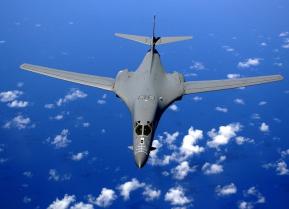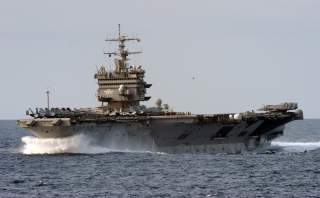The U.S. Navy's Dream: 12 Aircraft Carriers (But It Can't Happen Until 2060)
A new report from the Congressional Research Service (CRS) throws cold water on the prospects for 12 carriers. According to the CRS, it might take the Navy until the 2060s to stabilize the carrier fleet at a dozen vessels. Even that might be optimistic.
The U.S. Navy is struggling to grow its fleet of aircraft carriers.
In December 2016, then-Navy secretary Ray Mabus announced a new force-structure goal for the U.S. fleet. Under Mabus's plan, the sailing branch would expand from around 280 front-line warships to 355 in order to better compete with the growing Chinese navy.
The larger fleet would include 12 large aircraft carriers, up from 11 in the fleet in 2019. China commissioned its first carrier in 2012 and commision its second flattop in 2019. A third Chinese carrier is under construction in Shanghai.
The Trump administration largely has stuck with Mabus's plan, and slowly has boosted the Navy's shipbuilding accounts. But a new report from the Congressional Research Service throws cold water on the prospects for 12 carriers.
According to the CRS, it might take the Navy until the 2060s to stabilize the carrier fleet at a dozen vessels. Even that might be optimistic.
Aircraft carriers are the backbone of the U.S. fleet. Generally sailing in strike groups consisting of at least one cruiser, two destroyers, an attack submarine and a fast supply vessel and embarking an air wing with as many as 70 aircraft, carriers drive the Navy's planning and account for much of the fleet's combat power.
The number of carriers wildly has fluctuated in recent decades. In the late 1980s the Navy maintained 15 carriers -- and 585 other warships -- as part of the Reagan administration's military build-up.
But carriers are expensive. They cost billions of dollars to build and additional billions of dollars annually to man, equip and operate.
When the Cold War ended, the Navy steadily cut the flattop fleet to a low of 10 vessels in late December 2017. This despite a 2006 law requiring the Navy to maintain 12 carriers. A 2007 amendment to that policy allowed the fleet to drop down to 11 carriers. The dip to 10 flattops lasted just eight months before a new, 11th carrier commissioned into service in the summer of 2017.
Now that the Navy is determined to get to, and stay at, 12 carriers, it must face the hard truth. Meeting that goal could prove difficult or impossible. Indeed, the flattop fleet might shrink to a new low of nine ships before it stabilizes at a dozen.
A carrier can serve around 50 years before wear and tear and the need to refresh its nuclear powerplant make its continuing operation uneconomical. Throughout the 1990s and early 2000s, the Navy bought just one carrier every five years, a pace of construction adequate to ensure a 10-carrier fleet over the long term.
The CRS parsed the problem in a February 2019 report.
"Given the time needed to build a carrier and the projected retirement dates of existing carriers, increasing the carrier force from 11 ships to 12 ships on a sustained basis would take a number of years," the CRS reported.
"Procuring carriers on three-year centers—that is, procuring one carrier every three years—would achieve a 12-carrier force on a sustained basis by about 2030, unless the service lives of one or more existing carriers were substantially extended," the research service added.
"Procuring carriers on 3.5-year centers (i.e., a combination of three- and four-year centers) would achieve a 12-carrier force on a sustained basis no earlier than about 2034, unless the service lives of one or more existing carriers were substantially extended.
"Procuring carriers on four-year centers would achieve a 12-carrier force on a sustained basis by about 2063—almost 30 years later than under 3.5-year centers—unless the service lives of one or more existing carriers were substantially extended."
The Navy has made efforts to speed up the pace of carrier purchases. In February 2019 the Navy paid Virginia shipbuilder Huntington Ingalls $15 billion to begin work on two new Ford-class carriers.
CVN-80, the future USS Enterprise, would commission in 2027. The yet-unnamed CVN-81 would commission in 2030.
But even the two-flattop contract doesn't alter the long-term math, according to the CRS. "The Navy projects that under the [fiscal year] 2019 30-year shipbuilding plan, the carrier force would reach 12 ships in FY2022 to FY2024, then drop back to 11 ships and remain there in subsequent years, except for FY2040, FY2042 to FY2044 and FY2046 to FY2047, when it would drop to 10 carriers, and FY2048 (the final year in the 30-year period), when it would drop to nine carriers."
The Navy's only hope to sustainably boost the carrier fleet and avoid the 2048 dip to nine flattops is to consistently spend billions dollars more than it currently plans to spend as part of the build-up that Mabus originally proposed.
But even the Mabus plan could be optimistic. Mabus explained that his plan didn't take into account budget caps that Congress voted into law in 2011 amid a slow recovery from the 2008 recession and a legislative squabble with then-president Barack Obama.
There will be another recession. And American politics aren't likely to get less contentious. The extra billions of dollars the Navy assumes it annually will get from Congress over the next five decades might not be forthcoming.
In that case, a sustainable build-up to 12-carrier fleet could prove impossible over any timeframe.
David Axe serves as Defense Editor of the National Interest. He is the author of the graphic novels War Fix, War Is Boring and Machete Squad.


